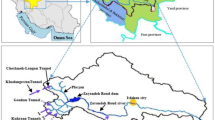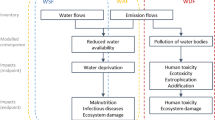Abstract
This study aimed to develop a common approach to investigate (blue) water footprint of consumption of municipalities. Analysis framework consists of two distinct phases as: water abstraction profile and water distribution and water use profile. In the proposed approach municipal water footprint (WFmunicipal) comprises three components: domestic water footprint (WFdomestic), industrial/commercial water footprint (WFindustrial/commercial), and public water footprint (WFpublic). The application of the methodology was demonstrated in Turkey. The overall objective was to identify water consumption profile regarding model components and assess spatial and temporal distributions in the country scale. In this scope, each component was determined for 81 cities. After the investigation of spatial differences, an answer to the question of, “whether water use is increasing or decreasing over time” was found. Results investigated that WFmunicipal was 140 L/ca.day in average and reached up to 300 L/ca.day in some cities. WFdomestic was about 100 L/ca.day and cities having lower values mostly located on north-west, south-east of the country. Furthermore, few spots with high values were observed for WFindustrial/commercial (with 10 L/ca.day average), and relatively lower values belonged to the cities in south-eastern region. WFpublic having 30 L/ca.day mean value had extremes in eastern part. Based on water consumption characteristics, cities were grouped using factor analysis and results created four groups of cities. Although eastern and western cities had no trends in water abstraction rate, other regions had decreasing trend in last 20 years. Investigation of (blue) water footprint of consumption of municipalities is believed to assist water managers to identify water use profiles and assess spatial and temporal distributions. This is important because water resources are becoming increasingly stretched to accommodate continued population and economic growth and to restore environmental flows.








Similar content being viewed by others
References
Aldaya, M. M., Chapagain, A.K., Hoekstra, A. Y., & Mekonnen M. M. (2012) The water 361 footprint assessment manual: setting the global standard. Water Footprint Network. Earthscan Publishing:
Boyacioglu, H. (2006). Surface water quality assessment using factor analysis. Water SA, 33, 389–393.
Boyacioglu, H., & Boyacioglu, H. (2008). Investigation of temporal trends in hydrochemical quality of surface water in western Turkey. Bulletin of Environmental Contamination and Toxicology, 80, 469–474.
Fulton, J., Cooley, H. & Gleick, P.H. (2012). California’s water footprint. Oakland: Pasific Institute.
Ge, L., Xie, G., Zhang, C., Li, S., Qi, Y., Cao, S., & He, T. (2011). An evaluation of China’s water footprint. Water Resources Management, 25, 2633–2647.
Hoekstra, A. Y. (ed) (2003). Virtual water trade: Proceedings of the international expert meeting on virtual water trade, 12–13 December 2002, value of water research report series no 12, UNESCO-IHE, Delft, Netherlands, www.waterfootprint.org/Reports/Report12.pdf.
Hoekstra, A.Y., Chapagain, A.K., Aldaya, M.M. and Mekonnen, M.M. (2009). Water footprint manual: State of the art 2009, Water Footprint Network, Enschede, the Netherlands. Available from: http://www.waterfootprint.org/downloads/WaterFootprintManual2009.pdf.
Manzardo, A., Loss, A., Fialkiewicz, W., Rauch, W., & Scipioni, A. (2016). Methodological proposal to assess the water footprint accounting of direct water use at an urban level: a case study of the municipality of Vicenza. Ecological Indicators, 69(2016), 165–175.
Minitab 15 (2007) . Minitab Statistical Software. Minitab Inc.
Sallam, O. M. (2014). Water footprints as an indicator for the equitable utilization of shared water resources (case study: Egypt and Ethiopia shared water resources in Nile Basin). Journal of African Earth Sciences, 100(2014), 645–655.
SPSS-20 (2011) IBM SPSS Statistics 20.0.
Stefano, L.D. & Llamas, M.R. (2013). Water, agriculture and the environment in Spain: Can we square the circle? Boca Raton: CRC Press.
Symeonidou, S. & Vagiona, D. (2015) The water footprint project within a geographically delineated area: the state of the art. Proceedings of the 14th International Conference on Environmental Science and Technology Rhodes, Greece, 3–5 September 2015.
Turkish Statistical Institute-TUIK (2017). Water statistics. Accessed on January 15 2017 from http://www.turkstat.gov.tr/PreTablo.do?alt_id=1019.
UNEP (2011) Water footprint and corporate water accounting for resource efficiency. Nairobi: United Nations Environment Programme (UNEP).
Vanham, D., & Bidoglio, G. (2014). The water footprint of Milan. Water Science & Technology, 69(4), 789–795.
World Bank (2016). Unaccounted for water. Accessed on November 15 2016 from http://web.worldbank.org/WBSITE/EXTERNAL/COUNTRIES/MENAEXT/EXTMNAREGTOPWATRES/0,,contentMDK:22356658~pagePK:34004173~piPK:34003707~theSitePK:497164,00.html.
Zeng, Z., Liu, J., Koeneman, P. H., Zarate, E., & Hoekstra, A. Y. (2012). Assessing water footprint at river basin level: A case study for the Heihe River Basin in northwest China. Hydrology and Earth System Sciences, 16, 2771–2781.
Author information
Authors and Affiliations
Corresponding author
Rights and permissions
About this article
Cite this article
Boyacıoğlu, H. Internal (blue) water footprint of municipal consumption: a case study for Turkey. Environ Monit Assess 190, 403 (2018). https://doi.org/10.1007/s10661-018-6779-z
Received:
Accepted:
Published:
DOI: https://doi.org/10.1007/s10661-018-6779-z




